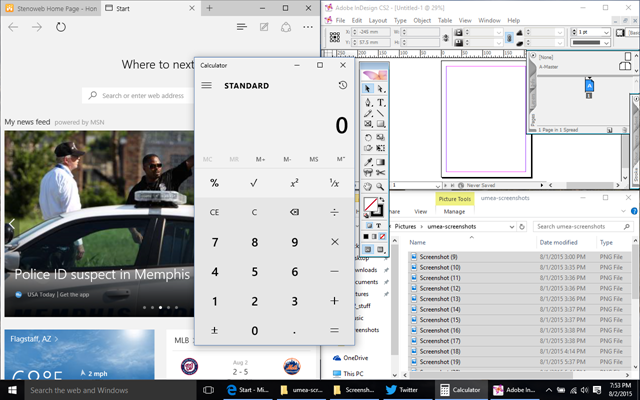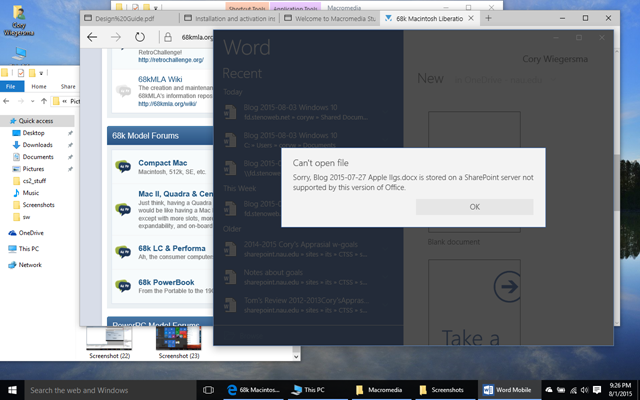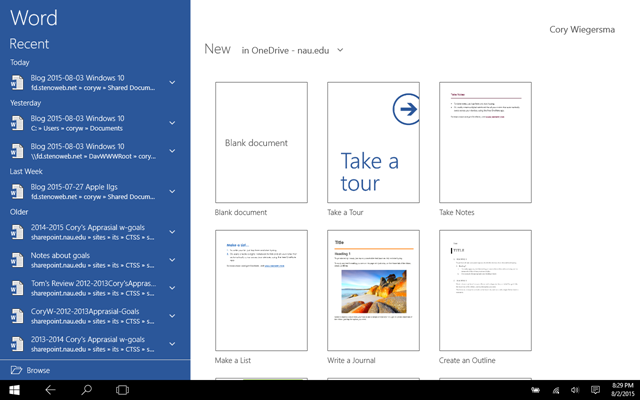Microsoft has released Windows 10. In celebration of this, I've recently finished refreshing one of my ThinkPads, umea. Umea is a ThinkPad R61, which I have recently finished giving a Core2Duo T8300 CPU, 4 gigabytes of RAM, and a new 500 gigabyte hard disk. I was less than totally impressed with the performance of the Windows 10 Tech Preview on this machine, but I think it comes down to needing a new application of thermal paste. Even with the new paste as I was installing the BIOS update, the machine had come alive.

Overall, I'm cautious but optimistic about Windows 10. I'm planning on using it on some of my secondary systems, but for pure tablet operation, it appears to be a regression from Windows 8, and while Windows 8 was an unfinished thought going in, Windows 10 still appears actually unfinished, from the perspective of reliability and performance.
It's interesting to see how people have been framing things. About a year ago, many people online were starting to come to terms with Windows 8's interface. Conceptually, it's a little weird that from the perspective of the tablet interface laying on top, everything you do on the desktop counts as a single "app" – but it also works well if you use the desktop alongside a New Interface application such as a Twitter, news, or e-mail application.
Windows 8 had two personalities, and they were, for the most part, complete, independent, and fully fledged personalities. There was a desktop calculator and a tablet calculator, a desktop mail application and a tablet mail application, a desktop Internet Explorer and a tablet Internet Explorer, and so on.
Windows 10 is a shift in gears in that it tries to build a Windows with one core personality. The problem I'm having is that I think that the new unified Windows 10 personality, which is said to be really desktop-centric and is supposed to appeal to Windows 7 users, is a regression from either of Windows 8's personalities, which were, once you got down to it, relatively well integrated.
For example, Windows 10 has a new calculator. It's touch-friendly, which is good if you're using Windows 10 on a Surface or other tablet. Unfortunately, this means that it's visually huge and doesn't match the visual appearance of most of the other programs on the display.

The Microsoft Edge web browser is an even more extreme case. The browser is pretty obviously designed for tablet interfaces. Touch targets are really huge and tab management is really rudimentary. I bet it's great on a touch display where you can slide the list of tabs back and forth, but it's not that great on a keyboard and mouse system where there's no way to get a list of tabs or to easily slide through the list of tabs without individually visiting every tab between say, the second (where you are now) and the fiftieth.

One of the other challenges of Windows Universal Applications is that on low-memory systems, they're subject to just being thrown out of memory. It's a lot like the way that iOS and Android manage memory, and Windows 8 has done this with New Interface applications, but it seems like a violation to position an application on a desktop and to kill it. What's worse is that unlike Apple's way of managing the memory used by desktop applications, Windows 10 Universal applications simply go away.
This alone (if the regressions in the tablet and desktop interfaces aren't enough of a deterrent) should discourage users of low-resource systems from using Windows 10. Even with four gigabytes of RAM, I saw Universal applications just stop, they'd go away and you'd have no idea what happened. There's no pop-up notification about this, nor does the program stay visible but just go dormant, functionally (a thing that can happen on Mac OS X.) This is terrible design and there's really no good way to tell somebody (people you've been trying to train for years that most good computers can handle having several applications running at once) that Windows killed their software for no good reason.
One of both the best and worst things about Windows 10 is that it's said to be a rolling release. The bits that were released are from build 10240. It's a relatively stable build with a fair amount of polish, but it's far from perfect. I haven't even talked about the problems my desktop experienced with the nVidia GeFORCE drivers, or with the problems relating to start menus on systems with a large number of applications and potential Windows Explorer stability issues.
Many people say that because of the "Windows as a Service" idea, these things are going to be fixed eventually and Microsoft had to eventualy ship the operating system. Yearly releases seem not to have worked out very well for Apple, who has focused on adding user-visible features rather than re-defining the core concepts of how their OS works or even improve the stability, performance, and efficiency of the system.
On the other hand, Microsoft may handle it far better than Apple did, and I can see a build 10270 appearing with improved support for nVidia graphics cards and a more robust, less crashy Windows Explorer.
The problem I can see is that I don't know whether any of the problems I have are going to be "fixed" because most of the issues I have basically center around my belief that Windows 8 still does both tablet and desktop interfaces better than Windows 10 does, so far.
Part of this is that I have displays at home that aren't huge. The R61i's display is 1280x800, my desktop has a monitor that's 1600x900, and I think it would bother me less if I were using almost exclusively displays that were 1920x1200 or 2560x1440.
One thing I've been doing on the R61i is using it with the new Universal versions of the Office apps. This primarily means word. Previously, this was a pretty good experience, and it worked almost the same as Word Online. Now, I don't know if this is a configuration error or what, but I wasn't able to open this document and edit it in "Word Mobile" on my Windows 10 computer. As such, I had to write it in Word 2013 in Windows 8.1U1 on my Surface 3.

Nevertheless, I'm excited for the Office Mobile apps' presence on the Windows 10 desktop, because I think that they make a great strategy for a "free" Microsoft Office on low-cost devices. The problem now is that Microsoft has to really differentiate using those applications on Windows 10 from an iPad or Android device. If an iPad or a Nexus 9 is going to run Word as well as a Windows tablet, and will actually function with documents on my SharePoint server, there's no compelling reason for me to keep using a Windows device in that manner.
That said, a lot of the negative press about Windows 10 hasn't actually been technical problems with the release, but with Microsoft's continued march toward integrating Windows and Office with Microsoft accounts, using either OneDrive or OneDrive for Business. Most of this started in Windows 8. You can sign into the operating system with your Microsoft Account, and if you do, it will automatically pull down all of your settings, configure your Hotmail/Live/Outlook.com account in the Mail/Calendar/People applications, sign you into Skype, and even configures wireless settings for you.
You know that thing where you remember your own wireless password, but not that of anybody else you know? If your computer and phone are both signed into your Microsoft Account, you won't have that problem where you bought a new computer and now you need to ask for the Wi-Fi password at your parents' house again.

Windows 10 also adds Cortana, Microsoft's digital voice assistant, launched on Windows Phone as a response to Siri. It's the same (or an extremely similar) voice to Cortana, the assistant in the Halo series of games on the Xbox platform. This is one of the more significant points of Windows 10 alarmism. Cortana, like Siri, Alexa, and Google Now, records personal information about you in order to assist it providing relevant information. Essentially, Cortana is another application on your computer, but it's very general purpose and you give it access to a lot of your information. On an iPhone, Siri has access to most of the system, and I believe this is how Cortana works on Windows Phone. It makes sense, then, that Cortana on Windows should be given the same access. You can disable Cortana, and I may yet.
I haven't decided whether or not I like the idea of a resident voice assistant on my computer. Maybe a better way to phrase it is that I've long liked the idea. It's far from new. Apple deployed it to a limited extent in the 1990s in the form of PlainTalk, but at that point it was really limited to running AppleScripts and issuing commands to an exceedingly small software base of (mostly Claris) applications. I haven't yet tried Cortana, on either Windows 10 or Windows Phone 8, but I'll provide some more information here when I do.
For desktop users one of the best things is that Microsoft has finally copied Spaces Mission Control (which themselves are copies of a concept that other systems have had for years.)

This could be the thing that draws me into Windows 10. I love this. Every time I sit down at a mac, I separate everything I do into task workspaces and it's one of the things that has prevented me from specifically needing dual monitors on any of my Mac laptops. It also makes total sense, because Apple integrated it with their full-screen app implementation, and they're using it as the basis for how they're doing side-by-side applications in Mac OS X 10.11 El Capitan.
Unfortunately, Windows 10 completely nerfs full-screen applications and if you have a Universal app (such as Word Mobile) it simply fills the screen the way Windows applications have been doing for years. The taskbar still shows. This is the case in tablet view as well. This both wastes space if you're using any display with a low resolution, and leaves a lot of UI chrome visible.

Tablet users are out of luck though, Microsoft's strategy there is to show everything in full screen. The Task View button takes you to a screen where you can pick from all of the running applications on your system.

In fact, I'd say that tablet users are out of luck in a lot of ways. For example, the start screen loses the direct links to all apps and the settings unless you make a second click or tap to one of two links to second-level menus.

One thing that's nice to find out is that it is possible to do the old tiling in tablet mode, but if you relied specifically on being able to treat the entire desktop as one tile. One of the problems is that depending on the particular way you actually enter tablet mode, you might end up with a situation where you have some windows or applications that were already snapped next to one another in "desktop" mode, then you flip to tablet mode, they're pinned next to one another, you do some things, and then when you come out of tablet mode, they've got some new friends on their space. If you enter tablet mode on a different virtual desktop, nothing will be joined together. This is a shame if you use a mobile or convertible device and become very specific about using spaces to manage contexts, tasks, or projects.
The core concepts for Windows 10 come from a good place. It's an attempt at bringing the "desktop" up to date with what people expect out of mobile operating systems. I like the new notification center, I'll get used to the new notification center (I even like the way it provides more quick access to common settings) and the spaces functionality may actually totally win me over.
However, it feels like in order to progress, we lost something along the way. I'm not using Windows 10 on any of my main computers yet, but on the computers where I am, I find myself pining for a much larger display, or just wishing that Windows 10 worked and looked as well as Windows 8 does, as a desktop operating system.
